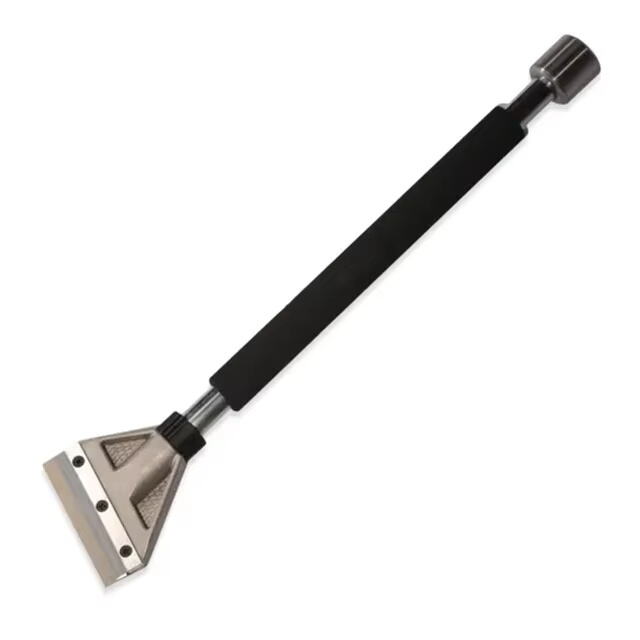완벽한 마감을 위한 벽면 준비
벽면 처리는 한 가지 핵심 단계인 사전 준비부터 시작됩니다. 잘 준비된 표면은 페인트, 벽지 또는 질감 처리가 얼마나 잘 부착될지를 결정합니다. 표면 준비의 핵심 도구는 스크래퍼입니다. 오래된 페인트를 제거하거나 표면 결함을 고치거나 벽지 잔여물을 제거하는 작업에 있어 올바른 스크래퍼를 선택하는 것이 스크레이퍼 매끄럽고 전문적인 결과와 번거로운 재작업을 결정할 수 있습니다. 스크래퍼는 다양한 형태와 재질로 제공되며, 각각 특정 작업을 효율적으로 수행하도록 설계되었습니다.
스크래퍼 종류 및 용도
수동 스크래퍼
매뉴얼 스크래퍼 벽 처리 준비에 있어 가장 전통적이고 널리 사용되는 도구입니다. 이러한 휴대용 도구는 금속 블레이드와 손잡이로 구성되어 있어 뛰어난 조작성을 제공합니다. 이들은 벗겨진 페인트 제거, 벽 마감제의 표면을 매끄럽게 정리, 작은 면적의 벽지 제거에 이상적입니다. 손쉬운 사용성으로 인해 DIY 작업이나 전문 작업 현장에서 필수적인 도구입니다. 고품질 수동 긁개는 교체 가능한 블레이드와 장시간 사용 시 피로를 줄이는 인체공학적 손잡이를 갖추고 있습니다.
예리한 날 긁개
예리한 날을 장착한 긁개는 정밀 작업에 뛰어난 성능을 발휘합니다. 이는 스티커나 접착제 자국, 그리고 표면 손상 없이 끈기 있는 벽지 잔여물을 제거하는 데 적합합니다. 매우 날카로울 수 있기 때문에 취급 시 주의가 필요합니다. 이러한 긁개는 석고나 유리와 같은 매끄럽고 단단한 표면에서 가장 효과적으로 사용되며, 마무리 작업에서 세심한 주의가 필요한 경우에 선호됩니다.
벽 재질에 맞는 긁개 선택
드라이월과 석고 벽
드라이월 및 석고 표면은 압력과 기술의 섬세한 균형이 필요합니다. 이러한 소재에는 약간 유연한 블레이드를 가진 긁개를 사용하는 것이 좋습니다. 이는 표면의 작은 결함 위를 부드럽게 미끄러지면서 벽을 파손시키지 않고 긁을 수 있습니다. 특히 더 부rit한 석고 벽의 경우, 힘을 고르게 분산시키기 위해 넓은 긁개를 사용하는 것이 중요합니다. 올바른 긁개를 선택하면 수리 작업을 최소화하고 후속 처리를 위한 매끄러운 표면을 확보할 수 있습니다.
콘크리트 및 벽돌
콘크리트나 벽돌로 된 벽은 더 거친 표면을 가지므로 내구성이 뛰어난 강성이 강한, 일반적으로 스테인리스강 블레이드를 사용하는 긁개가 필요합니다. 이러한 긁개는 거친 질감을 처리할 수 있도록 설계되었으며 장시간의 긁기 작업에도 마모에 강합니다. 또한 충분한 레버리지를 적용할 수 있도록 긴 손잡이가 있는 긁개를 선택하는 것이 유리합니다. 야외 또는 산업용 응용 분야에서는 견고한 긁개가 철저한 청소와 표면 준비를 보장합니다.

블레이드 재질 선택하기
스테인레스 스틸 날개
스테인리스강 블레이드는 부식에 강하고 매우 내구성이 뛰어나 장기간 사용에 이상적입니다. 날카로움을 오래 유지하며 실내 및 실외 프로젝트 모두에 적합합니다. 이러한 블레이드는 마른 페인트와 접착제 층 등 다양한 물질을 처리할 수 있습니다. 일관된 결과를 원하는 전문가들 사이에서 선호되는 선택입니다.
탄소강 날개
탄소강 블레이드는 더 날카롭고 유연하여 섬세한 작업에 탁월합니다. 그러나 관리가 제대로 이루어지지 않으면 녹이 발생하기 쉽습니다. 이러한 블레이드는 실내 프로젝트나 날카로운 모서리가 필수적인 상황에 이상적입니다. 정기적인 청소와 가끔 기름칠을 통해 수명을 연장할 수 있습니다.
핸들 디자인 및 인체공학
편안함과 잡음
스크래퍼의 손잡이는 블레이드만큼 중요합니다. 인체공학적 설계는 손의 피로를 줄이고 특히 장시간 사용 시 조작성을 향상시켜 줍니다. 고무 처리되거나 인체공학적으로 설계된 손잡이는 추가적인 편안함을 제공하며 미끄러짐을 방지합니다. 스크래퍼를 선택할 때는 항상 손잡이의 느낌을 확인하여 작업 강도에 적합한지 확인해야 합니다.
손잡이 길이 및 레버리지
긴 손잡이의 스크래퍼는 높은 곳이나 접근이 어려운 부위에 도달하거나 더 큰 압력을 가할 때 훌륭합니다. 짧은 손잡이의 모델은 섬세한 작업에 더 뛰어난 조절성을 제공합니다. 일부 스크래퍼는 조절 가능한 손잡이를 갖추어 두 가지 장점을 모두 제공합니다. 작업에 맞는 손잡이 길이를 선택하면 효율성과 편안함을 높일 수 있습니다.
특수한 요구에 맞춘 전용 스크래퍼
멀티툴 스크래퍼
멀티툴 스크래퍼는 여러 도구의 기능을 하나로 결합합니다. 자주 사용하는 모서리들은 절단, 긁어내기 또는 컴파운드를 펴는 용도로 활용되며, 이러한 스크래퍼는 시간을 절약하고 도구 낭비를 줄이려는 리모델링 업자에게 매우 유용합니다. 다양한 기능을 갖추고 있어 예측할 수 없는 벽면 작업 준비에 이상적입니다.
열활성 스크래퍼
여러 층의 페인트 또는 고집한 접착제를 제거하기 위해 열 활성화 스크래퍼는 열 총과 금속 스크래퍼를 결합하여 열 총을 사용합니다. 열은 재료를 부드럽게 하고, 더 쉽게 긁을 수 있게 합니다. 이 시스템은 특히 오래된 건물의 복원 작업이나 벽 주변의 세부적인 목조 작업에 유용합니다.
스크래퍼 사용 시 모범 사례
날의 날카로움 유지
무딘 스크래퍼 날은 벽을 손상시키고 작업 강도를 증가시킬 수 있습니다. 정기적으로 날을 점검하고 갈거나 교체함으로써 스크래퍼가 효과적으로 작동하도록 유지해야 합니다. 대부분의 전문가용 스크래퍼는 교체가 용이한 날을 사용합니다. 여분의 날을 준비해두면 작업 중단 없이 프로젝트를 진행할 수 있습니다.
올바른 긁어내기 기술
적절한 각도와 압력을 가하는 것이 중요합니다. 스크래퍼를 벽면에 약 30~45도의 각도로 잡고 일정하고 고르게 스트로크를 가하십시오. 표면을 파내지 않도록 주의하세요. 더 단단한 부위의 경우, 긁기 전에 물이나 용매로 재질을 부드럽게 만드는 것이 좋습니다. 기술을 숙련하면 표면 손상을 줄이고 마감 품질을 향상시킬 수 있습니다.
안전 고려사항
보호장치
스크래퍼 사용 시 먼지, 페인트 부스러기 또는 화학 잔여물이 발생할 수 있습니다. 특히 납 성분이 포함되었을 수 있는 오래된 페인트를 다룰 때는 항상 보호 안경, 먼지 마스크 및 장갑을 착용해야 합니다. 안전한 작업 환경을 조성함으로써 건강을 보호하고 작업 현장을 깨끗하게 유지할 수 있습니다.
안전한 보관
날이 날카로운 스크래퍼는 사용하지 않을 때 보호 커버나 공구함에 보관해야 합니다. 이는 예기치 못한 부상 방지와 도구 수명 연장에 도움이 됩니다. 또한 스크래퍼 종류에 라벨을 붙여두면 프로젝트 진행 시 빠르게 선택할 수 있습니다.
스크래퍼 관리 방법
청소 및 유지보수
사용 후마다 스크래퍼 블레이드와 손잡이를 청소하여 이물질, 접착제 또는 용제를 제거하십시오. 금속 블레이드의 경우, 녹 방지 오일로 빠르게 닦아주면 날카로움을 유지하고 부식을 방지할 수 있습니다. 나무 또는 고무 손잡이는 변질을 막기 위해 깨끗하고 건조하게 유지해야 합니다.
스크래퍼 교체 시기
정기적으로 관리하더라도 모든 스크래퍼는 수명이 존재합니다. 블레이드가 파손되거나 수리 불가능할 정도로 녹슬었거나 손잡이가 흔들리는 경우 도구를 교체해야 합니다. 손상된 스크래퍼를 사용하면 표면이 고르지 못해지며 작업 효율이 떨어집니다.
자주 묻는 질문
벽지 제거에 가장 적합한 스크래퍼 종류는 무엇인가요?
벽지 제거에는 넓은 블레이드가 있는 수동 스크래퍼 또는 면도날 스크래퍼가 가장 효과적입니다. 보다 효율적인 작업을 위해 벽지 연화제와 함께 사용하는 것이 좋습니다.
모든 벽면 유형에 동일한 스크래퍼를 사용할 수 있나요?
일부 스크래퍼는 다용도로 사용할 수 있지만, 최상의 결과를 얻기 위해서는 벽면 유형에 맞춰 스크래퍼 종류와 블레이드 재질을 선택하는 것이 좋습니다.
스크래퍼 블레이드를 어떻게 갈아야 하나요?
날카로운 금속 파일 또는 갈고제를 사용하여 직선 날을 복원하십시오. 항상 블레이드의 원래 각도를 따라가며 효과를 유지하십시오.
페인트칠이 된 석고보드에 긁개를 사용하는 것이 안전한가요?
네, 하지만 유연한 블레이드를 가진 긁개를 선택하고 석고보드 표면의 페인트를 손상시키지 않도록 부드럽게 사용하십시오.


